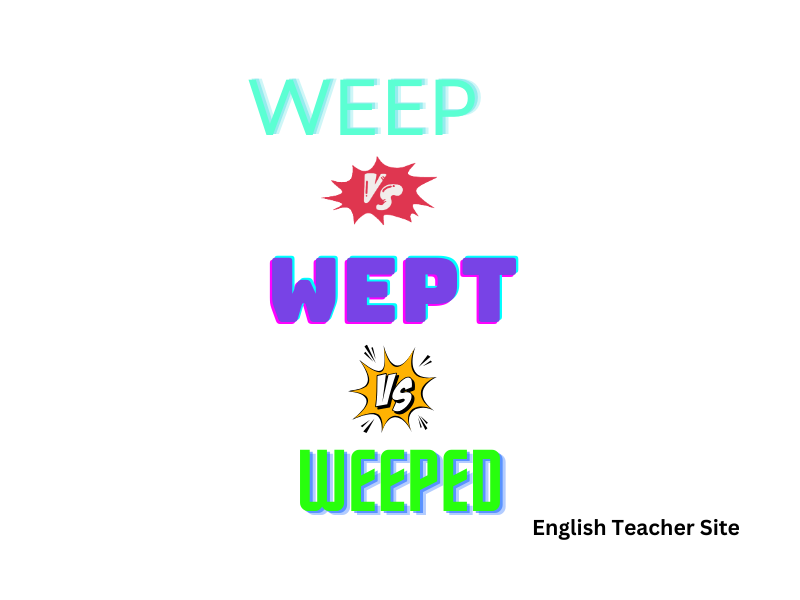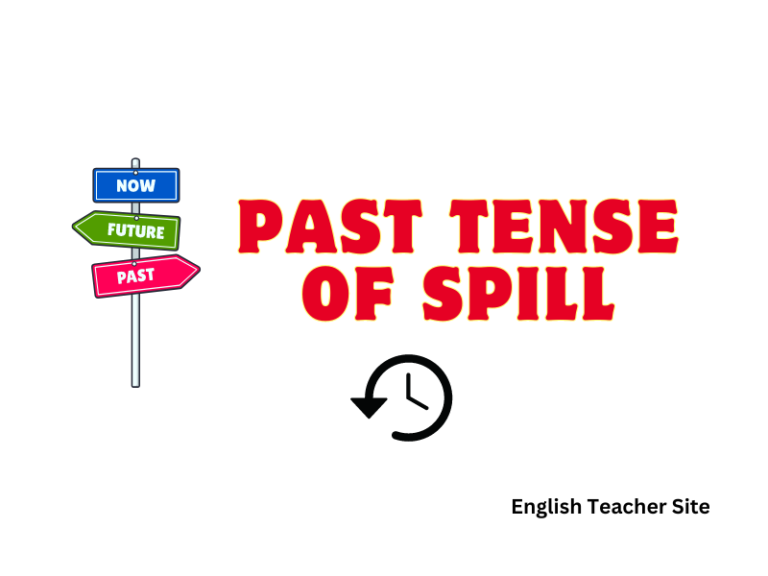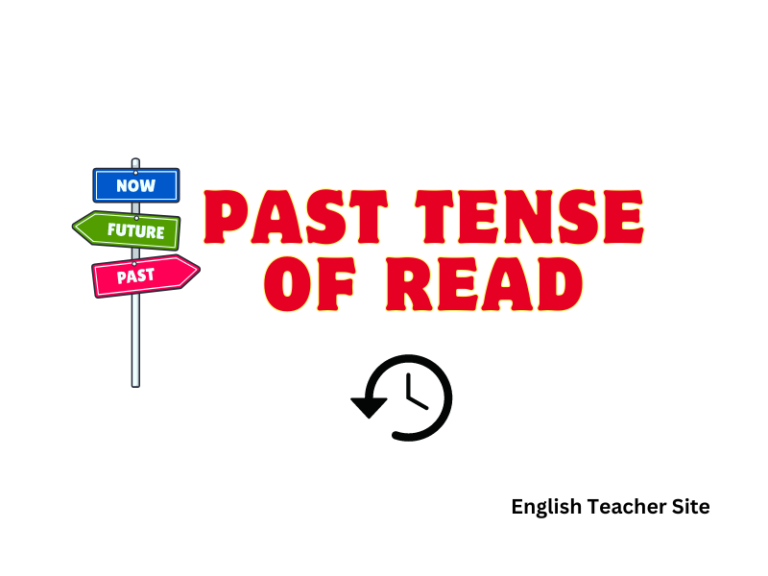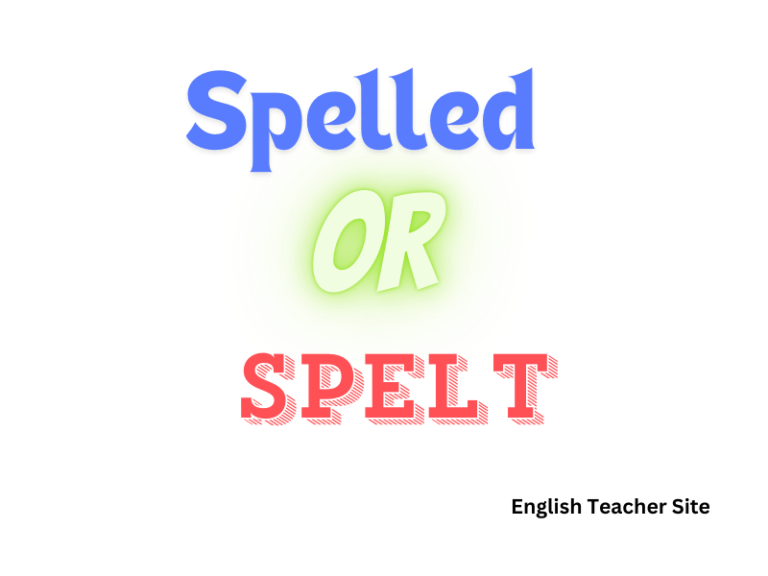What’s the Past Tense and Past Participle of Weep? Understanding Weeped vs Wept

- “Wept” is both the past tense and past participle form of “weep.”
- “Weep” is an irregular verb and does not follow the standard “-ed” pattern for past tense.
- Understanding verb conjugations is essential for correct English grammar.
In the English language, verbs can often trip up even the most seasoned grammarians when it comes to their past forms. This holds true for the verb “weep,” which means to shed tears or to cry. The correct past tense and past participle form of “weep” is not immediately obvious to everyone, hence the confusion that frequently arises. The debate centers around whether “weeped” or “wept” should be used in these cases.
What’s the Past Tense and Past Participle of Weep: Weep, Weeped, Wept
When discussing the verb “weep,” it is essential to understand its correct forms in different tenses, particularly in the past tense and past participle.
Exploring the past tense and past participle forms of the verb “weep.”
The verb “weep” has two significant past forms that are often confused. In modern English, “wept” is the accepted past tense and past participle form. Here is a clear presentation of the forms:
| Tense | Form |
|---|---|
| Past Tense | wept |
| Past Participle | wept |
It’s worth mentioning that “weeped” is an archaic form and is no longer standard in contemporary English usage. When conjugating the verb “weep,” one should therefore use “wept” for both the simple past tense: “Yesterday, she wept silently,” and the past participle: “He has wept at the end of the movie.”
- Infinitive: to weep
- Simple past: wept
- Past participle: wept
The use of “weep” in sentences varies depending on the context:
- Active voice sentence in simple past: “She wept throughout the night.”
- Active voice sentence with past participle: “He has wept openly in sorrow.”
Boldening “wept” herein emphasizes the correct usage, aiming to clarify for learners and readers alike that “wept” is the form to use when referring to events in the past. Remember, using “weeped” is a common mistake and may be considered incorrect in both academic settings and standard English communication.
What’s the Past Tense of “Weep”?
The past tense of the verb “weep” is determined by its role in a sentence and the timeline of the action it describes.
When discussing events that have already happened, “weep” follows an irregular conjugation pattern. Unlike regular verbs that simply add -ed to form the past tense, “weep” changes its spelling entirely:
- Present: weep
- Past Simple: wept
- Past Participle: wept
Forms of “Weep” in Different Tenses
| Tense | Form |
|---|---|
| Present Simple | weep |
| Past Simple | wept |
| Present Participle | weeping |
| Past Participle | wept |
| Future Simple | will weep |
In both the past simple tense and the past participle, the form “wept” is used. This transformation is a key characteristic of irregular verbs within the English language.
Example Sentences Using “Wept”
- Simple Past: She wept when she heard the news.
- Present Perfect: They have wept for hours.
These examples indicate that “wept” serves as the correct conjugation for expressing actions in the past, whether they occurred in isolation or have relevance to the present.
What Do We Mean by Weep? Forms of the Verb to Weep:
The verb “weep” is often associated with crying, particularly heavy or emotional crying. It is a strong expression of sorrow, pain, or profound joy. Understanding the nuances of its forms is essential for clear and accurate communication in English.
Base Form:
- Weep
The base form “weep” serves as the present tense or can function with helping verbs to form other tenses and aspects.
Simple Past Tense:
- Wept
The simple past tense of “weep” is “wept,” which indicates an action that was completed in the past.
Past Participle:
- Wept
Like the simple past tense, “wept” also serves as the past participle and is used in perfect tenses and the passive voice.
The formation of the past tense and past participle of “weep” deviates from the standard pattern where “-ed” is added to the base form of regular verbs. Instead, “weep” undergoes an internal vowel change—this is why it is classified as an irregular verb.
Here is a quick summary of the principal forms of “weep”:
| Form | Weep |
|---|---|
| Base/Infinitive | weep |
| Simple Past | wept |
| Past Participle | wept |
Additionally, here are examples of “weep” in various tenses:
- Present Tense: “I often weep during sad movies.”
- Present Perfect Tense: “She has wept many times this month.”
- Past Perfect Tense: “He had wept before they arrived.”
Note: “Weeped” is not the correct form and should be avoided in both past and past participle constructions.
What’s the Past Tense and Past Participle of “Weep”?
The verb “weep” has an irregular past tense and past participle form that can sometimes cause confusion. This section focuses on clarifying the correct past tense and past participle forms of the verb “weep.”
Past Tense:
The simple past tense of “weep” is “wept.” This form is used to describe an action that has been completed in the past.
Past Participle:
The past participle of “weep” is also “wept.” The past participle is commonly used with auxiliary verbs to form perfect tenses.
The following tables provide a clear representation of “weep” used in various sentences:
| Tense | Sentence Example |
|---|---|
| Simple Past | Yesterday, she wept quietly. |
| Past Perfect | They had wept by the time we arrived. |
In addition, to demonstrate the usage of “weep” in compound tenses, see the examples below:
| Compound Tense | Sentence Example |
|---|---|
| Present Perfect | He has wept over the news. |
| Pluperfect (Past Perfect) | She had wept before resolving the issue. |
When using bullet points to emphasize key aspects:
- The verb “weep” follows the same pattern as “sleep.”
- Both the simple past tense and the past participle of “weep” are formed by changing the infinitive “weep” to “wept.”
- The verb “weep” is classified as an irregular verb because it does not follow the regular conjugation pattern of adding “-ed” to create its past forms.
- Auxiliary verbs such as “have” and “had” are used with “wept” to form perfect tenses.
Examples of the Verb “Weep” in the Present Tense
In English, the verb “weep” signifies the act of shedding tears. This can be due to a multitude of reasons, ranging from deep sorrow to extreme joy. When discussing the present tense, it’s important to consider the many ways this verb can be used to convey a current state or habitual action. Let’s look at some clear examples of “weep” in the present tense.
Singular Forms:
| Subject | Verb |
|---|---|
| He | weeps |
| She | weeps |
| It | weeps |
In singular forms, the verb takes on an ‘s’ at the end when paired with third-person singular subjects, such as “he,” “she,” or “it.”
- He weeps silently during the sad movie.
- She often weeps when reading heartfelt stories.
Plural Forms:
| Subject | Verb |
|---|---|
| I | weep |
| You | weep |
| We | weep |
| They | weep |
With plural forms or with “I” and “you,” the verb remains unchanged.
- They weep in joy at their reunion.
- We weep together in times of loss.
This verb is also often seen in the present continuous tense, especially to denote an action happening at this very moment.
- I am weeping because of the onion fumes.
- You are weeping at the end of the touching performance.
By examining these examples, one can see the verb “weep” accommodates different subjects by slightly altering its form. Remember, the usage of “weep” in the present tense can reflect both an action currently in progress or a repeated, general activity.
Examples of “Wept” in the Simple Past Tense
The verb “to weep” is an irregular verb, which means its past tense and past participle forms do not follow the regular pattern of adding “-ed” to the base verb. Instead, the simple past tense and past participle of “weep” is “wept.” Here are some examples that illustrate its use in the simple past tense.
Sentences using “wept”:
| Subject | Sentence |
|---|---|
| He | He wept quietly in his room after hearing the news. |
| She | She wept for joy at the wedding. |
| They | They wept in relief when they found the lost puppy. |
| It | It wept moisture from its cold surface, forming droplets. |
In these examples, “wept” is the main verb in the past tense, showing a completed action.
Contextual usage of “wept”:
- When describing a scene in a novel: The characters often experienced deep emotions, and the protagonist wept at the loss of her friend.
- In a historical account: The citizens wept upon hearing of the king’s passing.
- In everyday conversation: He mentioned that he wept during the emotional movie.
- Reflecting personal experiences: She recalled a time when she wept openly during a poignant speech.
Constructing sentences with varied subjects:
- Single subjects: He wept, she wept
- Plural subjects: They wept, both of them wept
- Non-human subjects: It, as in when referring to an inanimate object like the sky or a cloud, e.g., “It wept rain all through the night.”
These examples are indicative of how “wept” is used to convey a sense of past sorrow or relief in various contexts.
Sentence Examples with “Wept” as a Past Participle
The past participle form of a verb is used for perfect tenses and passive voice. “Wept” is the past participle form of “weep,” and here are some examples of how it is used in sentences:
Perfect Tenses:
- Present Perfect: She has wept silently in her room.
- Past Perfect: They had wept before the news arrived.
- Future Perfect: By tomorrow, he will have wept enough to accept the situation.
Passive Voice:
- A poem was written about the times he wept.
- The story was told of how the city had wept after the tragedy.
The following tables offer additional sentence examples in perfect tenses and passive voice constructions:
Table 1: Perfect Tenses using “Wept”
| Tense | Sentence Example |
|---|---|
| Present Perfect | “I have wept for those who do not cry for themselves.” |
| Past Perfect | “She had wept over the loss of her childhood friend.” |
| Future Perfect | “By the end of the film, they will have wept together.” |
Table 2: Passive Voice Constructions using “Wept”
| Construction | Sentence Example |
|---|---|
| Simple Passive | “Tales were told of how the willow trees wept.” |
| Perfect Passive | “The forgotten toys had been wept over by the child long ago.” |
Below are bullet point lists that further detail use cases for “wept”:
Carrying Emotional Weight:
- The word “wept” is often used to convey deep emotions or a sense of loss.
- “She wept” can be more evocative than simply saying “she cried.”
Literary Usage:
- “Wept” is a choice word in literature that enhances the emotional depth of a narrative.
- It’s not uncommon to encounter “wept” in poetic contexts, where nuance is key.
As shown, “wept” functions as a multi-faceted term, suited for a range of emotional and grammatical applications.
Other Words for Weep
When discussing the term “weep,” it’s essential to recognize alternatives that express similar emotions of sorrow or grief.
Synonyms for Weep:
- Cry: The most common alternative, typically used to express any act of shedding tears.
- Sob: To cry with convulsive catching of breath.
- Bawl: To cry loudly, often associated with children or a display of strong emotion.
- Lament: Has a mournful connotation, stressing the expression of grief or sorrow.
- Mourn: To express or feel sorrow or grief, often over someone’s passing.
| Verbs Relating to Weeping | Definition |
|---|---|
| Bleed | To feel deep sympathy or sorrow. |
| Blubber | To cry noisily, often uncontrollably. |
| Snivel | To cry with sniffling. |
| Wail | To express a prolonged, mournful cry. |
For individuals navigating emotions, these terms can offer a precise way to articulate their feelings.
| Terms for Quiet Weeping | Definition |
|---|---|
| Tear up | To begin to cry; usually refers to the welling of tears without audible sound. |
| Whimper | To make low, weak crying sounds. |
| Sniffle | To cry or sob with short, snorting sounds. |
- She grieved silently, her eyes brimming with unshed tears.
- They lamented the loss, their voices steeping in sorrow.
- He sobbed openly, his despair audible in the empty room.
Each term offers a unique insight into the human experience of sorrow, encapsulating the depth and breadth of feeling behind the act of weeping.
Phrases with “Weep”
When studying the English language, it’s fascinating to explore common phrases that use the verb “weep.” Here are some examples:
Common Idioms and Phrases:
- “Weep buckets”: To cry a great deal; to shed many tears.
- “Weep crocodile tears”: To display insincere sorrow; feigning sadness that one does not genuinely feel.
Usage in Literature:
Literary works often utilize the verb “weep” for dramatic effect. Authors might employ it to express a character’s profound grief or sorrow. For instance:
- “Weep for joy”: Crying as an expression of overwhelming happiness.
- “Weep one’s heart out”: To cry intensely, as if releasing one’s deepest emotions.
Here are two tables illustrating the verb “weep” conjugated into past tense and past participle, and how these forms are used in phrases.
Conjugation of “Weep”:
| Tense | Form |
|---|---|
| Past | wept |
| Past Participle | wept |
Phrases Using Past and Past Participle Forms:
| Phrase | Meaning |
|---|---|
| She wept silently throughout the night. | She cried silently throughout the night. |
| He has wept at the loss of his friend. | He has cried over the loss of his friend. |
Origin of the Verb/Word, Weep
The verb “weep” hails from a deep linguistic history, tracing back to Old English. Here, the word was spelled as weÞan, which has roots in Proto-Germanic *wopjan and ultimately stems from the Proto-Indo-European *wab-. This ancient form carries the same meaning related to crying or expressing sorrow through tears. The evolution of the word across different languages emphasizes a shared human expression of grief and suffering.
Timeline of the Verb “Weep”:
| Period | Form |
|---|---|
| Proto-Indo-European | *wab- |
| Proto-Germanic | *wopjan |
| Old English | weÞan |
Literature through the ages has preserved the transitions and fluctuations in the usage of “weep.” The transformation over time also included changes in spelling and pronunciation, reflecting broader linguistic shifts.
Development of Spelling:
- Early Middle English: The word took on forms such as weepen or weopen, with some variance influenced by regional dialects.
- Middle English: Spelling began to stabilize, and the word became more consistently recorded as weep.
The use of weep as both a verb and a noun (referring to the act of crying) indicates its versatility and the strength of its association with the physical and emotional act. It’s important to note that, while changes in language tend to simplify over time, “weep” has maintained its conjugation pattern, distinguishing itself by the irregular past tense and past participle forms, “wept.”
| Tense | Form |
|---|---|
| Present | weep |
| Past | wept |
| Participle | wept |
The foundation of “weep” in English is robust, anchored in a lineage stretching back to the dawn of the language. Its continued existence in modern English speaks to the persistence of its relevance and the universality of the emotions it conveys.
Source
1. Harper, Douglas. “Etymology of weep.” Online Etymology Dictionary, https://www.etymonline.com/word/weep.
My name is Khamis Maiouf. I am the creator of the English Teacher Site, dedicated to providing valuable resources and insights for students around the world. With a passion for education and a commitment to helping students enhance their skills, I aim to make English teaching more effective and enjoyable for both educators and students.






